Study on Dynamic Evolution and Erosion Characteristics of Cavitation Clouds in Submerged Cavitating Water Jets
Abstract
:1. Introduction
2. Experimental Plan
2.1. Experimental Setup
2.2. Numerical Simulation Methods
3. Discussion
3.1. Analysis of Dynamic Evolution of Cavitation Cloud
3.2. Analysis of Velocity Distribution of Nozzle Axial Jet
3.3. Analysis of Surface Morphology Damage of Specimens
4. Conclusions
- The diffusion angle of the cavitation cloud generated by the cylindrical nozzle is 17–19°, and the greater the pressure, the greater the diffusion angle of the cavitation cloud. A cavitation cloud has obvious periodicity, and there are four different stages of formation, development, detachment, and collapse within each cycle under different pressures. When in the development stage, the range of the cavitation cloud is largest.
- The distribution of the central water jet impact damage area and the cavitation area on the surface of the specimen varies with the target distance. As the target distance increases, the pits formed by the central water jet impacting the surface of the specimen gradually weaken; the degree of cavitation erosion first increases and the material surface shows a typical distribution of annular cavitation pits before decreasing. The impact degree of the central water jet decreases monotonically. The morphological changes on the surface of the specimen can provide data support for studying the erosion ability of cavitation jets. From a microscopic perspective, the intensification of cavitation erosion is the joint result of the growth of cavitation pits and their connection with adjacent pits.
- The submerged cavitation water jet generated by a cylindrical nozzle can be divided into three zones based on the attenuation rate of the nozzle axial velocity: a central jet action zone, a mixed action zone, and a cavitation action zone. The attenuation rate of the axial jet velocity of the nozzle in the central jet action zone is less than or equal to 82.5%, the attenuation rate of the axial jet velocity of the nozzle in the mixed action zone is greater than 82.5% and less than 96%, and the attenuation rate of the axial jet velocity of the nozzle in the cavitation action zone is greater than or equal to 96%. When the target distance is in the mixed action zone, the erosion effect is more obvious.
- This experiment was only conducted at room temperature, so further research could be conducted on the factors affecting temperature and the internal roughness of the nozzle based on existing data.
Author Contributions
Funding
Institutional Review Board Statement
Informed Consent Statement
Data Availability Statement
Conflicts of Interest
References
- Chu, H.; Guo, Y.; Zhang, N.; Liu, B.; Ren, M.; Hao, C.; Bi, W. Role of microparticles in enhancing jet cavitation and rock breaking ability. China Pet. Mach. 2023, 51, 34–42. [Google Scholar]
- Zhuang, D.; Zhang, S.; Liu, H.; Chen, J. Cavitation erosion behaviors and damage mechanism of Ti-Ni alloy impacted by water jet with different standoff distances. Eng. Fail. Anal. 2022, 139, 106458. [Google Scholar] [CrossRef]
- Luo, C.; Gu, J.; Xu, X.; Ma, P.; Zhang, H.; Ren, X. Impact of solid particles on cavitation behaviors and laser-induced degradation in aqueous suspension. Ultrason. Sonochem. 2021, 76, 105632. [Google Scholar] [CrossRef] [PubMed]
- Watanabe, R.; Yanagisawa, K.; Yamagata, T.; Fujisawa, N. Simultaneous shadowgraph imaging and acceleration pulse measurement of cavitating jet. Wear 2016, 358–359, 72–79. [Google Scholar] [CrossRef]
- Liu, B.; Pan, Y.; Ma, F. Pulse pressure loading and erosion pattern of cavitating jet. Proc. Math. Phys. Eng. Sci. 2020, 14, 136–150. [Google Scholar] [CrossRef]
- Soyama, H. Key factors and applications of cavitation peening. Int. J. Peen. Sci. Technol. 2018, 1, 3–60. [Google Scholar]
- Chillman, A.; Ramulu, M.; Hashish, M. Suitable region of high-speed submerged water jets for cutting and peening. JSME Int. J. Ser. B-Fluids Therm. Eng. 1995, 38, 31–38. [Google Scholar]
- Soyama, H. Surface mechanics design of metallic materials on mechanical surface treatments. Mech. Eng. Rev. 2015, 2, 14–00192. [Google Scholar] [CrossRef]
- Han, B. Numerical simulation and verification of cavitation behavior in water-jet cavitation peening processing. J. Mech. Eng. 2012, 48, 193–198. [Google Scholar] [CrossRef]
- Li, Z.; Jiang, X.; Deng, S. Research on the rust removal performance of cavitation water jet. China Storage Transp. 2009, 10, 109–111. [Google Scholar]
- Peng, K.; Tian, S.; Li, G.; Alehossein, H. Mapping cavitation impact field in a submerged cavitating jet. Wear 2018, 396, 22–33. [Google Scholar] [CrossRef]
- Trummler, T.; Schmidt, S.; Adams, N. Numerical prediction of erosion due to a cavitating jet. Wear 2022, 498–499, 204304. [Google Scholar] [CrossRef]
- Yang, Y.; Wang, G.; Shi, W.; Li, W.; Ji, L.; Wang, H.L. Turbulence characteristics in the mixing layer of a submerged cavitating jet at high reynolds numbers. Sustainability 2022, 14, 11963. [Google Scholar] [CrossRef]
- Fujisawa, N.; Fujita, Y.; Yanagisawa, K.; Fujisawa, K.; Yamagata, T. Simultaneous observation of cavitation collapse and shock wave formation in cavitating jet. Exp. Therm. Fluid Sci. 2018, 94, 159–167. [Google Scholar] [CrossRef]
- Liu, Y.; Wu, Q.; Huang, B.; Zhang, H.; Liang, W.; Wang, G. Decomposition of unsteady sheet/cloud cavitation dynamics in fluid-structure interaction via POD and DMD methods. Int. J. Multiph. Flow 2021, 142, 103690. [Google Scholar] [CrossRef]
- Pan, Y.; Ma, F.; Liu, B.; Cai, T. Cavitation intensity and erosion pattern of a self-excited cavitating jet. J. Mater. Process. Technol. 2020, 282, 116668. [Google Scholar] [CrossRef]
- Fujisawa, N.; Horiuchi, T.; Fujisawa, K.; Yamagata, T. Experimental observation of the erosion pattern, pits, and shockwave formation in a cavitating jet. Wear 2019, 418–419, 265–272. [Google Scholar] [CrossRef]
- Cai, T.; Pan, Y.; Ma, F. Effects of nozzle lip geometry on the cavitation erosion characteristics of self-excited cavitating waterjet. Exp. Therm. Fluid Sci. 2020, 117, 110137. [Google Scholar] [CrossRef]
- ASTM G134-17(2017); Standard Test Method for Erosion of Solid Materials by a Cavitating Liquid Jet. ASTM Internatianal: West Conshohocken, PA, USA, 2017.
- Wang, G.; Yang, Y.; Wang, C.; Shi, W.; Li, W.; Pan, B. Effect of nozzle outlet shape on cavitation behavior of submerged high-pressure jet. Machines 2021, 10, 4. [Google Scholar] [CrossRef]
- Soyama, H. Effect of nozzle geometry on a standard cavitation erosion test using a cavitating jet. Wear 2013, 297, 895–902. [Google Scholar] [CrossRef]
- Zhong, X.; Dong, J.; Liu, M.; Meng, R.; Li, S.; Pan, X. Experimental study on ship fouling cleaning by ultrasonic-enhanced submerged cavitation jet: A preliminary study. Ocean Eng. 2022, 258, 111844. [Google Scholar] [CrossRef]
- Dular, M. Hydrodynamic cavitation damage in water at elevated temperatures. Wear 2016, 346–347, 78–86. [Google Scholar] [CrossRef]
- Mednikov, A.; Zilova, O.; Tkhabisimov, A.; Dasaev, M.; Grigoriev, S. Parametric studies of effect of cavitation jet modes on wear rate of surface of structural materials. Metals 2023, 13, 48. [Google Scholar] [CrossRef]
- Fang, Z.; Ji, Z.; Kang, D.; Chen, Y.; Zhang, X.; Wang, S.; Xiong, T. Cavitation damage characteristics following marine fouling cleaning by a self-excited oscillation cavitation waterjet. Appl. Ocean Res. 2023, 139, 103692. [Google Scholar] [CrossRef]
- Li, L.; Xu, Y.; Ge, M.; Wang, Z.; Li, S.; Zhang, J. Numerical investigation of cavitating jet flow field with different turbulence models. Mathematics 2023, 11, 3977. [Google Scholar] [CrossRef]
- Yang, Y.; Li, W.; Shi, W.; Zhang, W.; El-Emam, M. Numerical investigation of a high-pressure submerged jet using a cavitation model considering effects of shear stress. Processes 2019, 7, 541. [Google Scholar] [CrossRef]
- Zhou, W.; He, K.; Cai, J.; Hu, S.; Li, J.; Du, R. Simulation and experimental study on cavitating water jet nozzle. In Proceedings of the International Conference on Environmental Engineering and Sustainable Development, Sanya, China, 9–11 December 2016. [Google Scholar]
- Zwart, P.; Gerber, A.; Belamri, T. A two-phase flow model for predicting cavitation dynamics. In Proceedings of the International Conference on Multiphase Flow, Yokohama, Japan, 30 May–3 June 2004. [Google Scholar]
- Cao, D.; He, G.; Pan, H.; Qin, F. Comparative investigation among three cavitation models for simulating cavitating venturi. J. Northwest. Polytech. Univ. 2013, 31, 596–601. [Google Scholar]
- Bao, C.; Long, X.; Liang, Y.; Zhang, Z.; Zhang, Z.L. Simulation analysis of cavitation flow and thrust characteristics of high-pressure waterjet propulsion. Chin. Hydraul. Pneum. 2023, 47, 32–43. [Google Scholar]
- Ji, B.; Cheng, H.; Huang, B.; Luo, X.; Peng, X.; Long, X. Research progresses and prospects of unsteady hydrodynamics characteristics for cavitation. Adv. Mech. 2019, 49, 428–479. [Google Scholar]
- Chen, S.; Li, W.; Zhang, W.; Hu, J.; Yang, Y.; Liu, M. Numerical analysis of shear cavitation flow characteristics of convergent-divergent nozzles. J. Drain. Irrig. Mach. Eng. 2023, 41, 275–280+287. [Google Scholar]
- Cao, X. Numerical Study on Cavitation Characteristics of Centralbody Nozzle Underwater Jet. Master’s Thesis, Jiangsu University of Science and Technology, Zhenjiang, China, 2023. [Google Scholar]
- Peng, K.; Tian, S.; Li, G.; Huang, Z.; Zhang, Z. Cavitation in water jet under high ambient pressure conditions. Exp. Therm. Fluid Sci. 2017, 89, 9–18. [Google Scholar] [CrossRef]
- Fujisawa, N.; Kikuchi, T.; Fujisawa, K.; Yamagata, T. Time-resolved observations of pit formation and cloud behavior in cavitating jet. Wear 2017, 386–387, 99–105. [Google Scholar] [CrossRef]
- Choi, J.K.; Chahine, G.L. Relationship between material pitting and cavitation field impulsive pressures. Wear 2016, 352–353, 42–53. [Google Scholar] [CrossRef]
- Field, J.E.; Camus, J.J.; Tinguely, M.; Obreschkow, D.; Farhat, M. Cavitation in impacted drops and jets and the effect on erosion damage thresholds. Wear 2012, 290–291, 154–160. [Google Scholar] [CrossRef]
- Alehossein, H.; Qin, Z. Numerical analysis of Rayleigh-Plesset equation for cavitating water jets. Int. J. Numer. Methods Eng. 2007, 72, 780–807. [Google Scholar] [CrossRef]

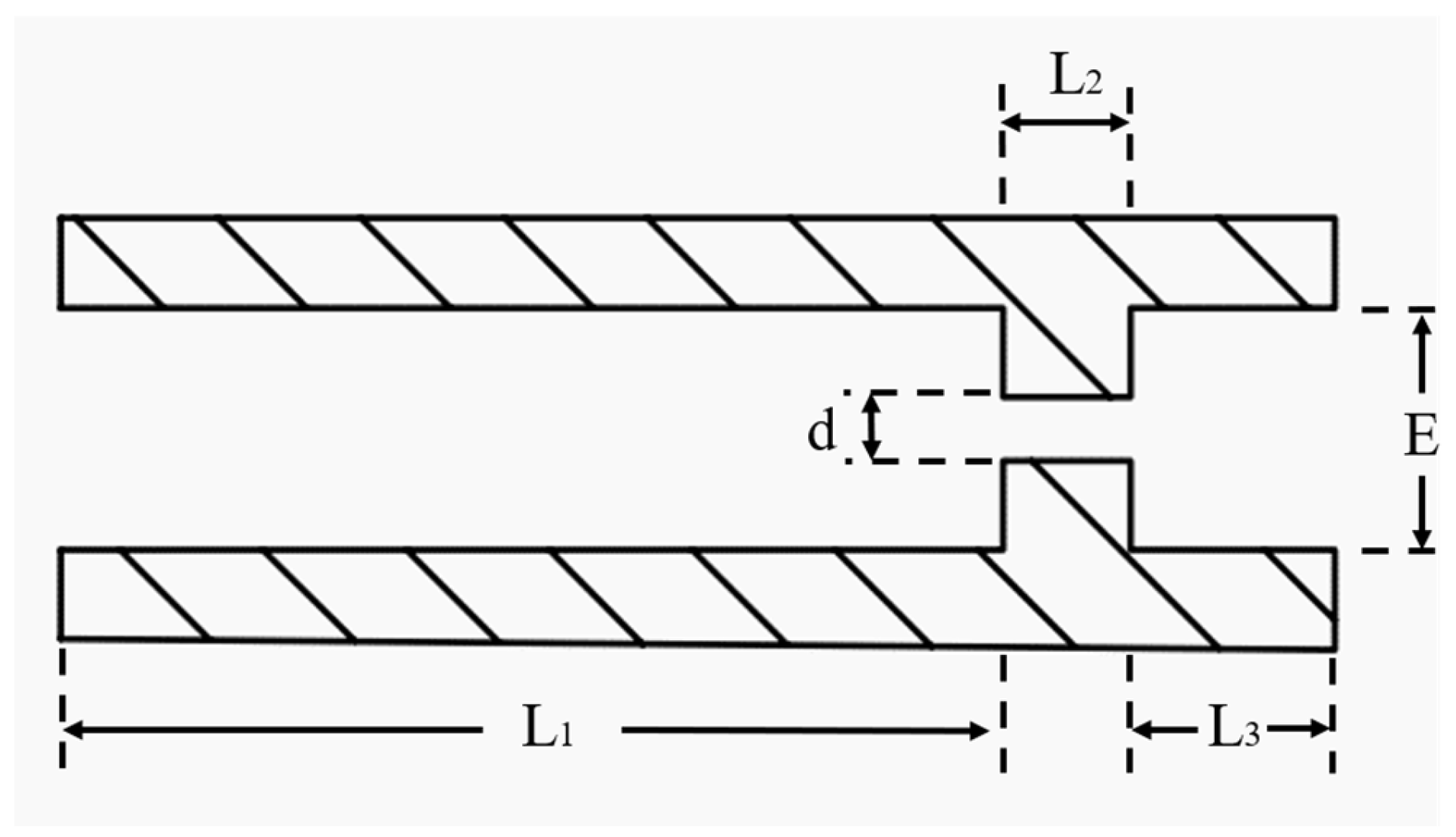

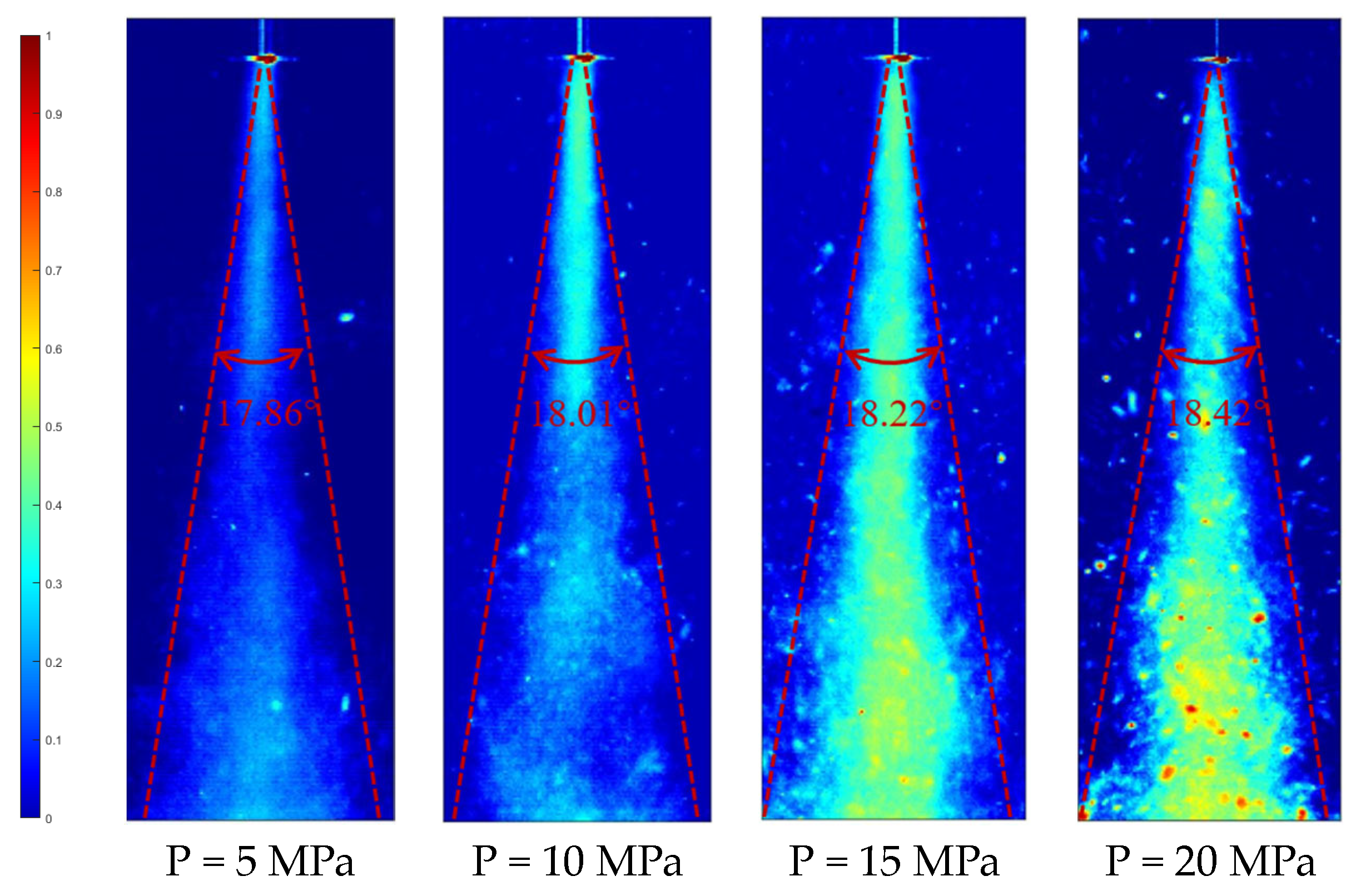
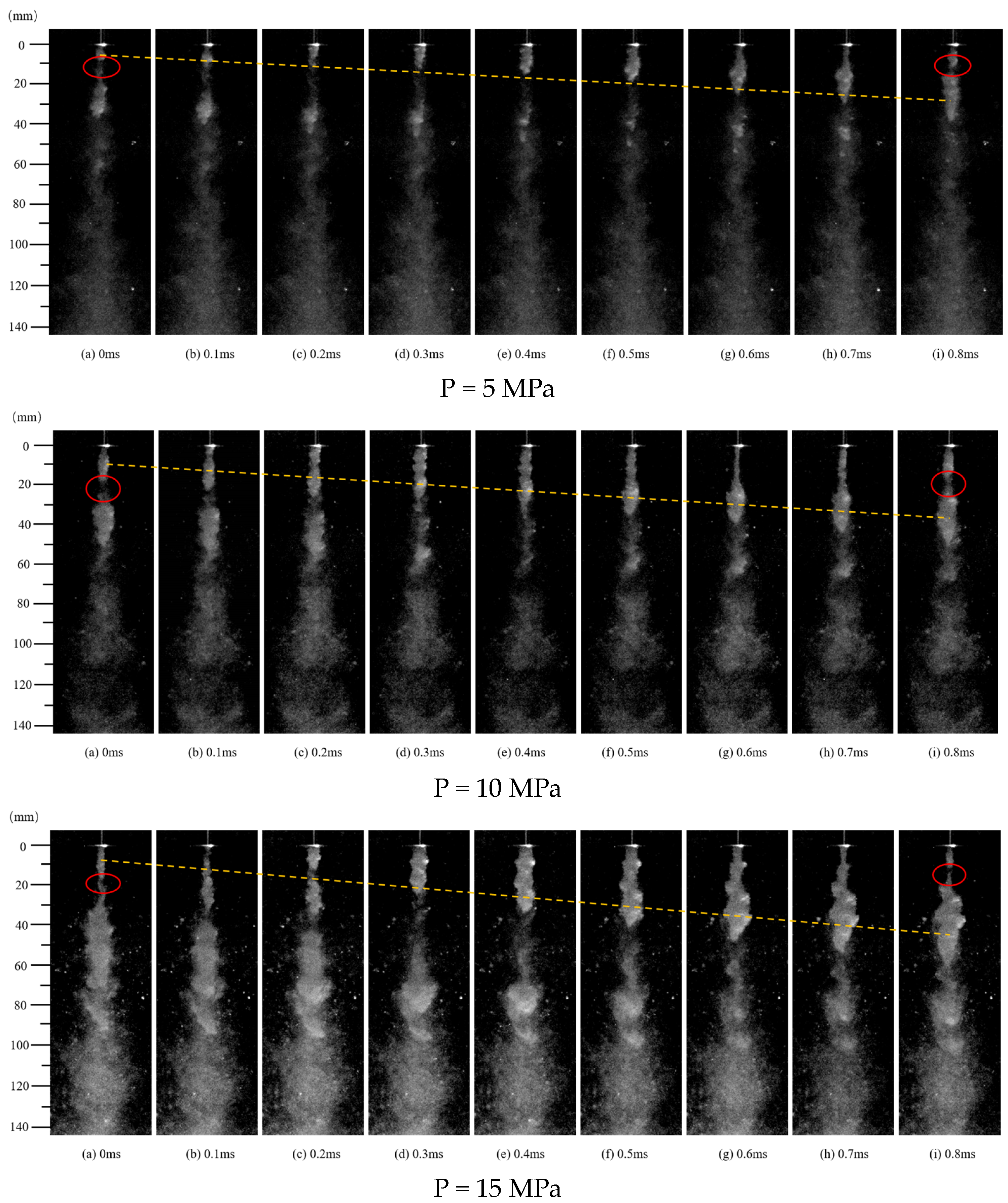
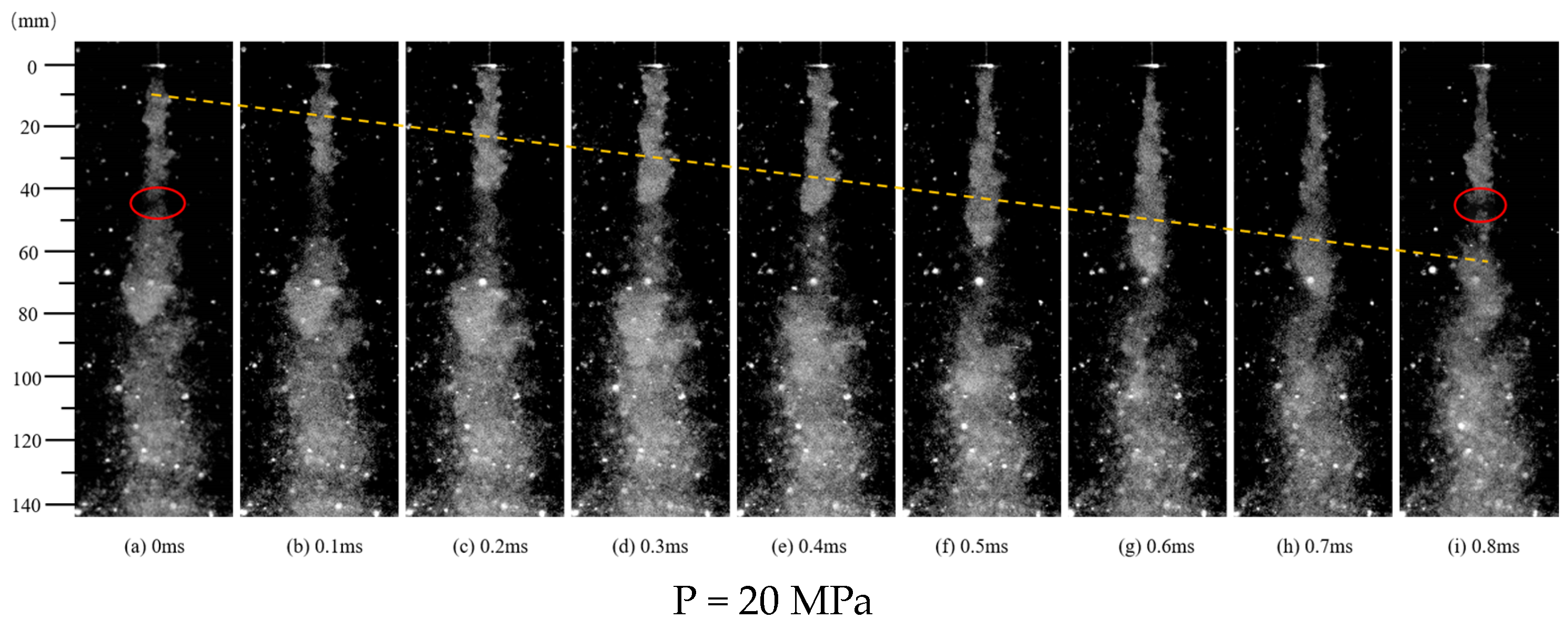
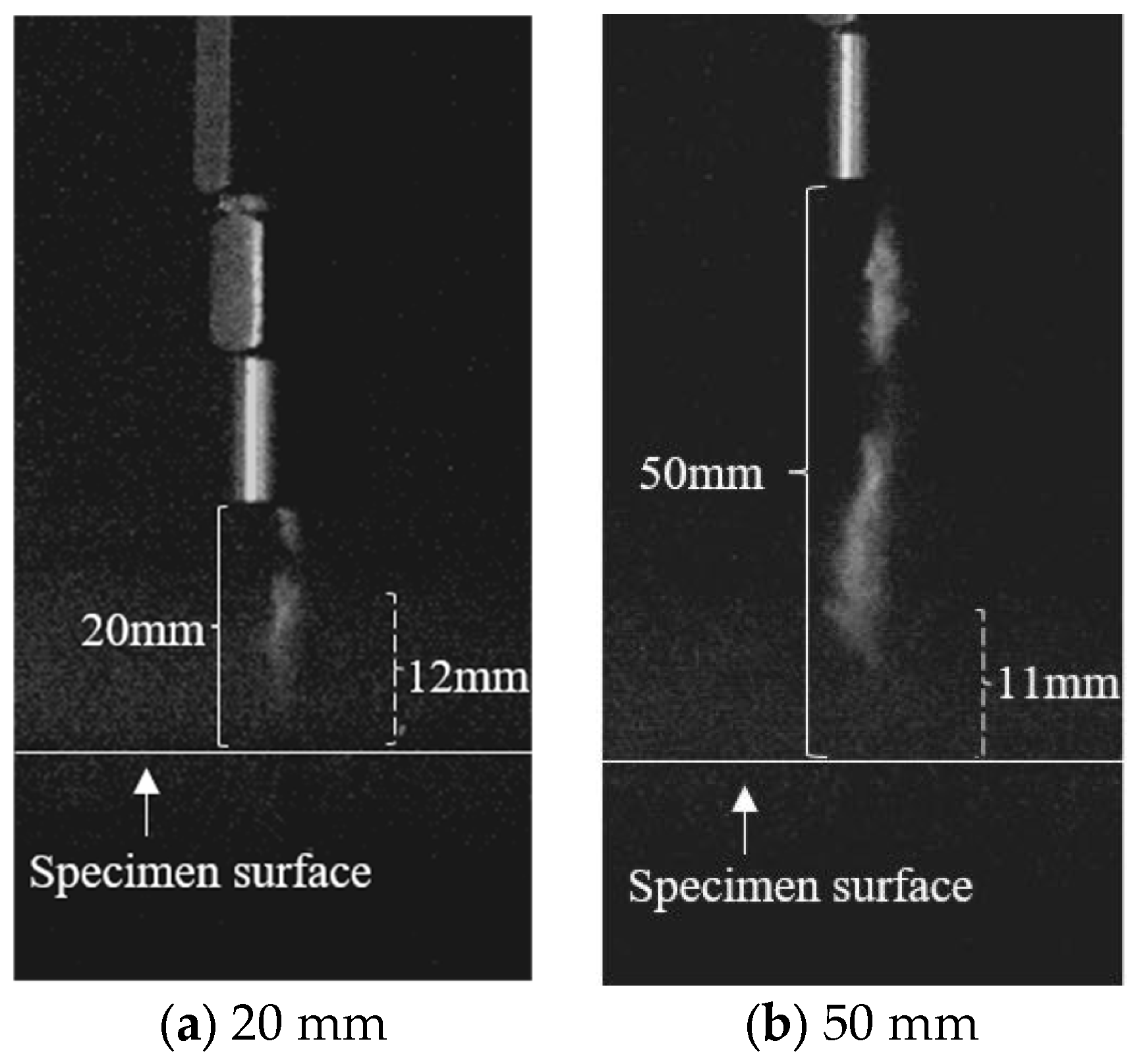

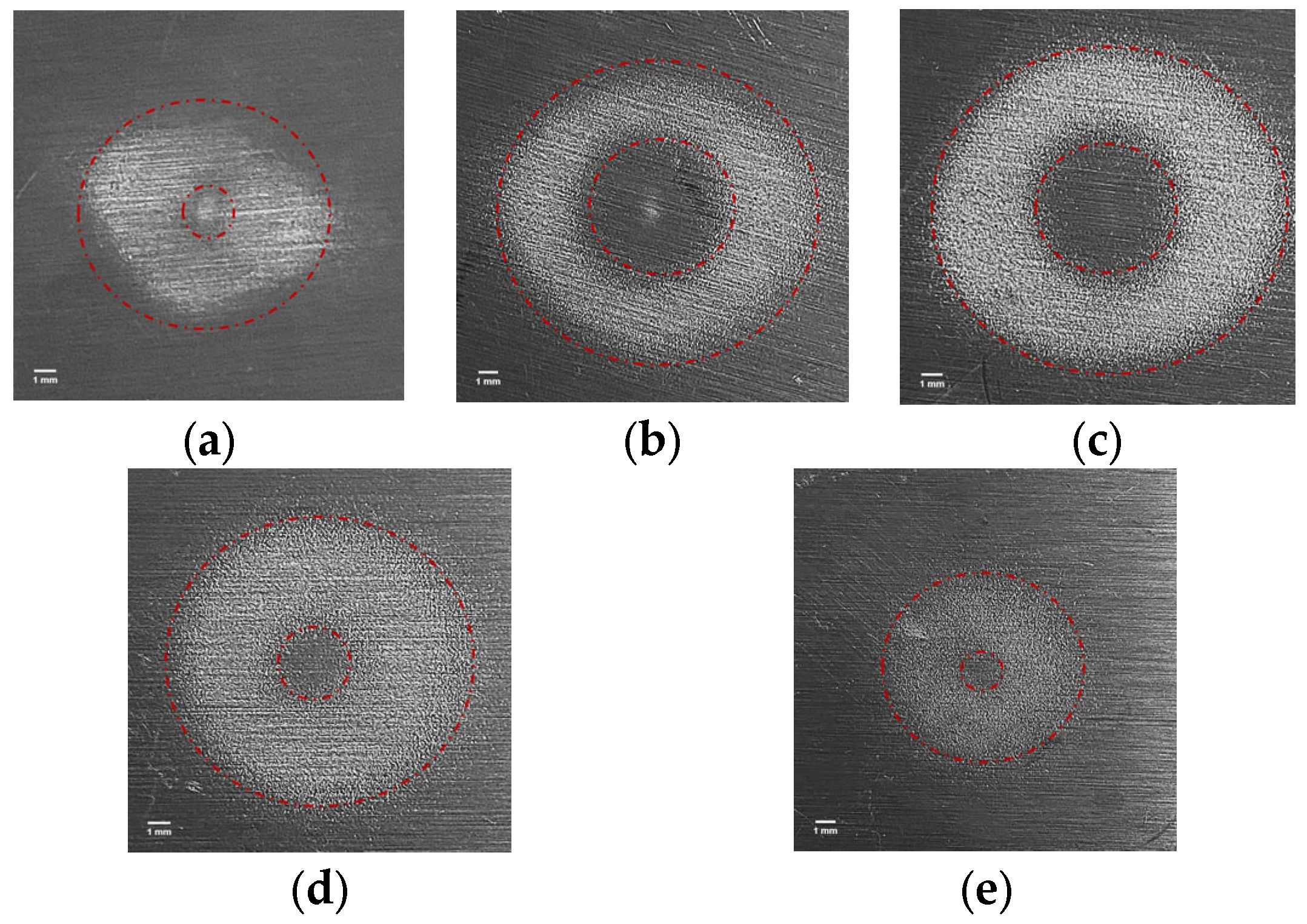


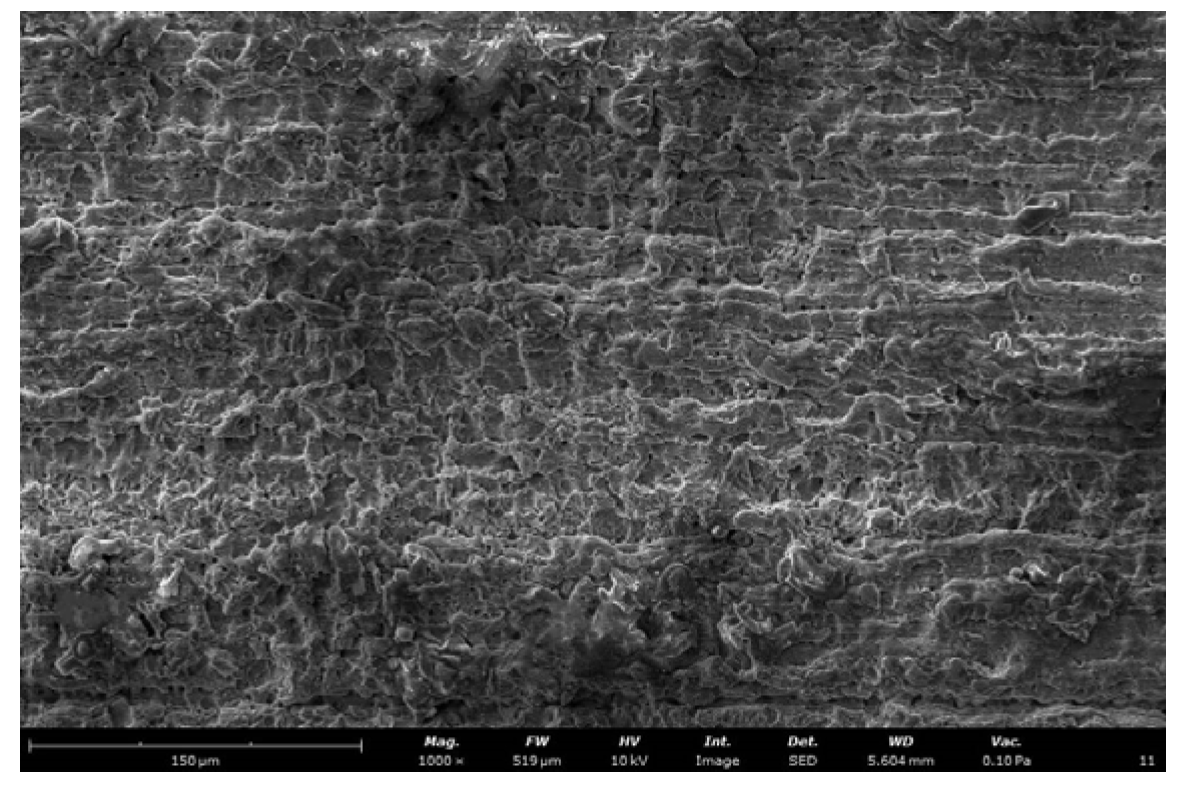
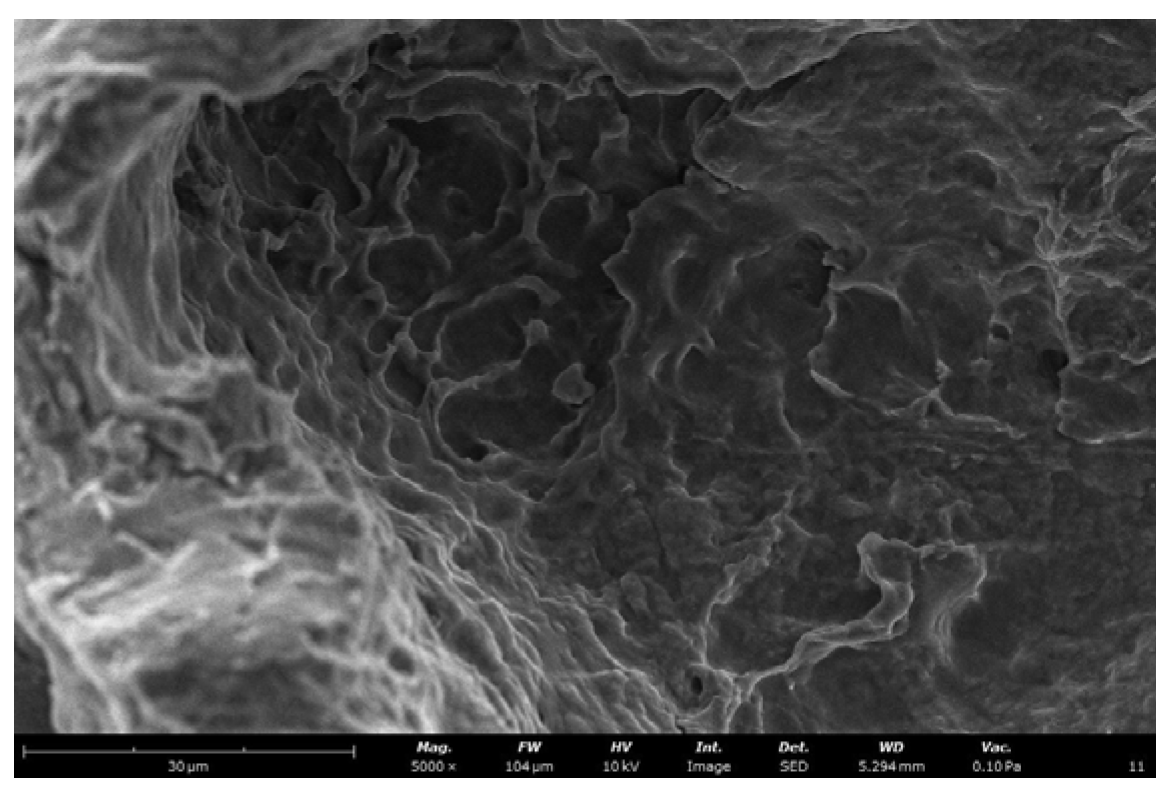
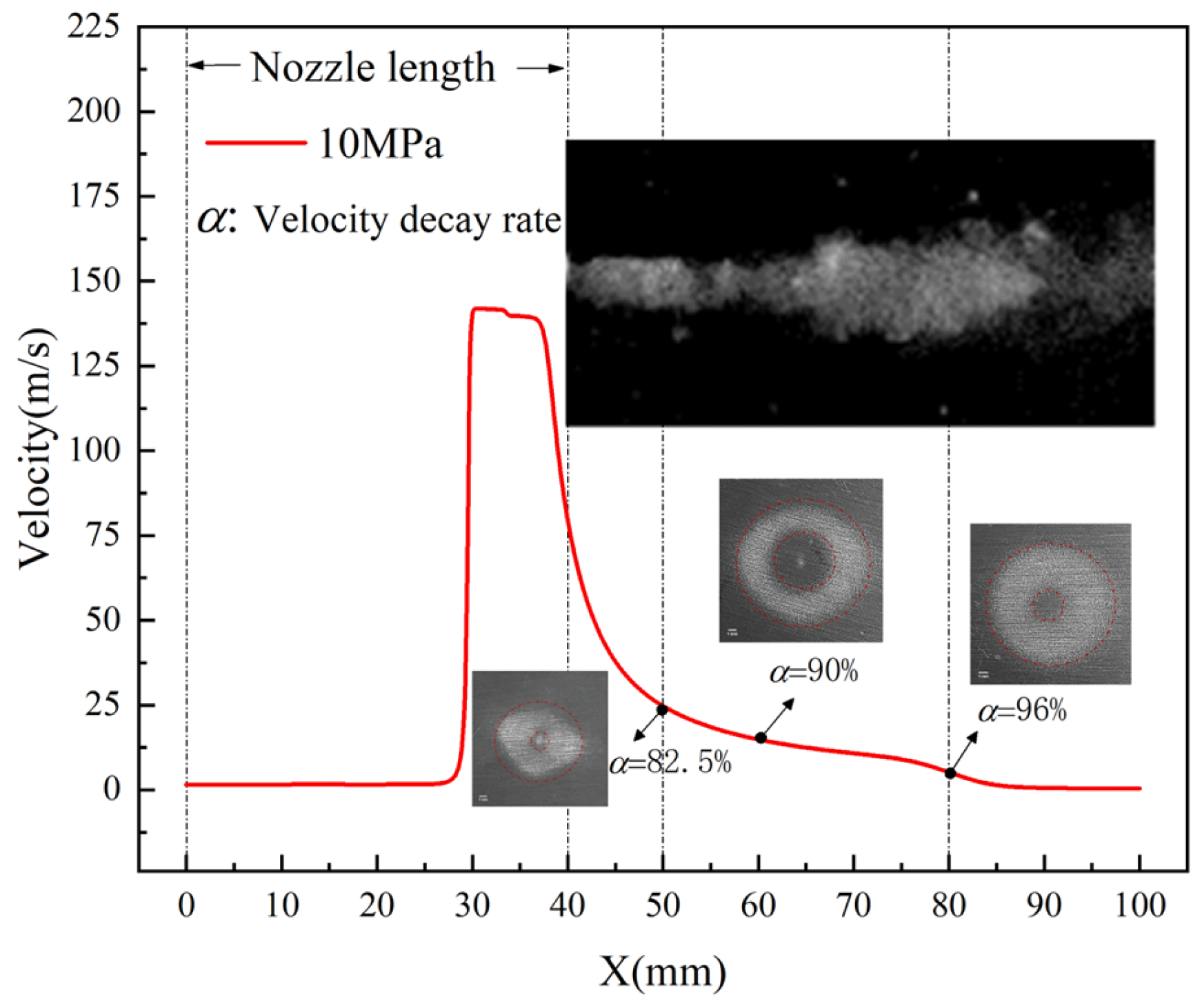
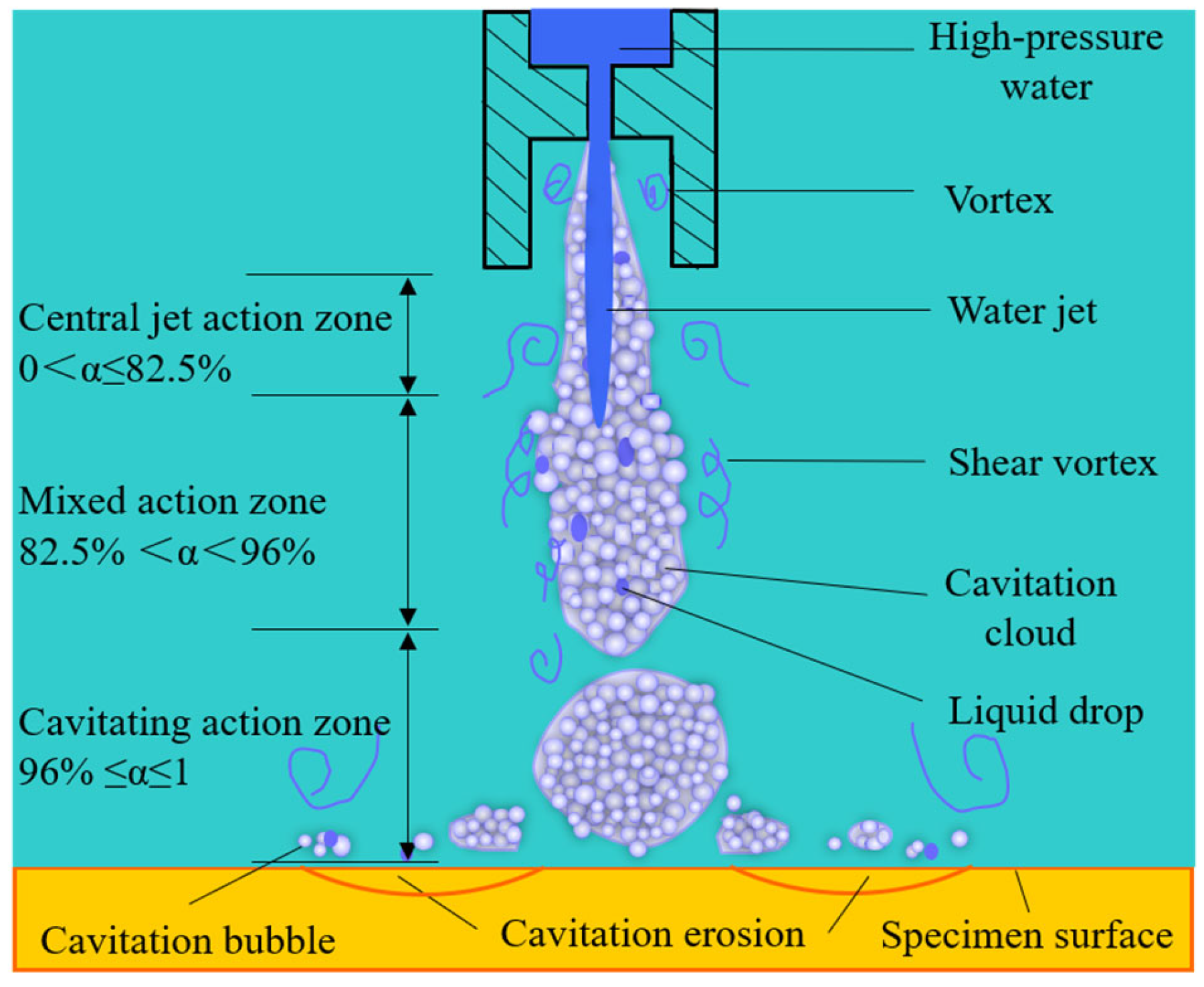
| Al | Cu | Mn | Mg | Zn | Cr | Ti | Si | Fe | Other |
|---|---|---|---|---|---|---|---|---|---|
| 98.5 | 0.15–0.4 | 0.15 | 0.25–0.6 | 0.25 | 0.04–0.35 | 0.15 | 0.6–1.2 | 0.7 | 0.15 |
Disclaimer/Publisher’s Note: The statements, opinions and data contained in all publications are solely those of the individual author(s) and contributor(s) and not of MDPI and/or the editor(s). MDPI and/or the editor(s) disclaim responsibility for any injury to people or property resulting from any ideas, methods, instructions or products referred to in the content. |
© 2024 by the authors. Licensee MDPI, Basel, Switzerland. This article is an open access article distributed under the terms and conditions of the Creative Commons Attribution (CC BY) license (https://creativecommons.org/licenses/by/4.0/).
Share and Cite
Cui, Y.; Zhao, M.; Ding, Q.; Cheng, B. Study on Dynamic Evolution and Erosion Characteristics of Cavitation Clouds in Submerged Cavitating Water Jets. J. Mar. Sci. Eng. 2024, 12, 641. https://doi.org/10.3390/jmse12040641
Cui Y, Zhao M, Ding Q, Cheng B. Study on Dynamic Evolution and Erosion Characteristics of Cavitation Clouds in Submerged Cavitating Water Jets. Journal of Marine Science and Engineering. 2024; 12(4):641. https://doi.org/10.3390/jmse12040641
Chicago/Turabian StyleCui, Yanyu, Manjun Zhao, Qingmiao Ding, and Bin Cheng. 2024. "Study on Dynamic Evolution and Erosion Characteristics of Cavitation Clouds in Submerged Cavitating Water Jets" Journal of Marine Science and Engineering 12, no. 4: 641. https://doi.org/10.3390/jmse12040641





